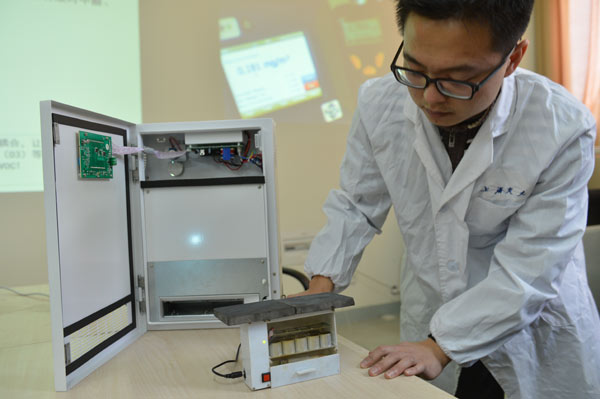University unveils new air purifier technology
China Daily, January 7, 2014 Adjust font size:
|
|
| A member of the Shanghai Jiao Tong University research team that invented a new air-purifying device demonstrates the machine. The device’s technology can prevent secondary pollution that existing air purifiers can create if not used properly. [Du Xin / for China Daily] |
Innovation removes pollutants by electrostatic and catalytic processes
Chinese researchers have developed a new technology to clean up indoor air pollution that avoids secondary pollution that existing air purification products in the market can create if used improperly.
The new air purifier, developed by a research team from the School of Mechanical Engineering at Shanghai Jiao Tong University, removes indoor pollutants from air through physical and chemical methods.
Professor Shangguan Wenfeng, who led the research project, said at a news conference on Monday that current air purifiers clean the air mainly by absorption and filtering, but this technique has problems.
“For example, the filter needs to be replaced regularly because it will easily reach the saturation point, which might lead to further pollution,” he said.
Also, while some machines cannot filter smaller pollutants well, the school’s new technology overcomes that shortcoming, he said.
The new technology removes indoor pollutants through high-voltage electrostatic and catalytic purification.
The electrostatics process the PM2.5 — airborne particles smaller than 2.5 micrometers that can go deep into the lungs — and other air pollutants from outdoors.
During this process, volatile organic compounds and a small amount of ozone are produced. The second, catalysis module transforms these harmful organic compounds and ozone into harmless carbon dioxide and water.
A test was conducted during the news conference. Because Shanghai air quality was classified as “good” at the time, researchers made a smoggy indoor environment in a 30-square-meter room by lighting six cigarettes. The PM2.5 reading soon reached 700 micrograms per cubic meter, far exceeding the index limit level of 500.
When the machine was switched on, the particles in the room gradually disappeared, with the reading less than 100 within an hour.
Another innovation of the air purifier is that it allows air circulation between indoors and outdoors. Indoor air is circulated with outside air through a ventilation pipe at the bottom of the machine.
“Even in heavy smoggy weather, the indoor air will continue circulating and be cleaned. This technology is not available in existing machines on the market,” Shangguan said.
Yang Xin, an environmental expert at Fudan University, expressed optimism about the invention.
“In recent years, air cleaners have become more and more popular among residents. A well-designed air purifier will undoubtedly play an important role in improving air quality,” he said.
Poor air quality has been heatedly discussed by the public recently as smog enveloped many cities in autumn and winter. PM2.5 has become the country’s primary polluter and also the main source of indoor air pollution.
In Beijing, the average PM2.5 reading in 2013 was more than double the national standard, according to a Beijing Environmental Protection Bureau report earlier this month.
On average, heavy air pollution occurred every six or seven days in the city, said Zhang Dawei, director of the Beijing Environmental Monitoring Center.
Shanghai, a city whose air was once considered clean, saw its Air Quality Index reach nearly 500 on Dec 6. An index reading over 300 is considered “hazardous”, the highest in a six-tier rating system of air quality.
Persistent smog across the country has prompted a surge in sales of dust masks and air cleaners. Sales of air-cleaning machines in 2013 increased 420 percent year-on-year, according to JD.com, China’s e-commerce giant.
“So far, this technology is very developed, and it has already been awarded a patent. We are now looking for manufacturers to help bring this product to market,” Shangguan said.
The research team said the retail price of the new air purifier would be competitive with similar machines on the market from big international brands like Blueair, Daikin, Philips and Siemens. The price is expected to be 3,000 yuan ($496) to 6,000 yuan depending on the size of the room it’s used for.


